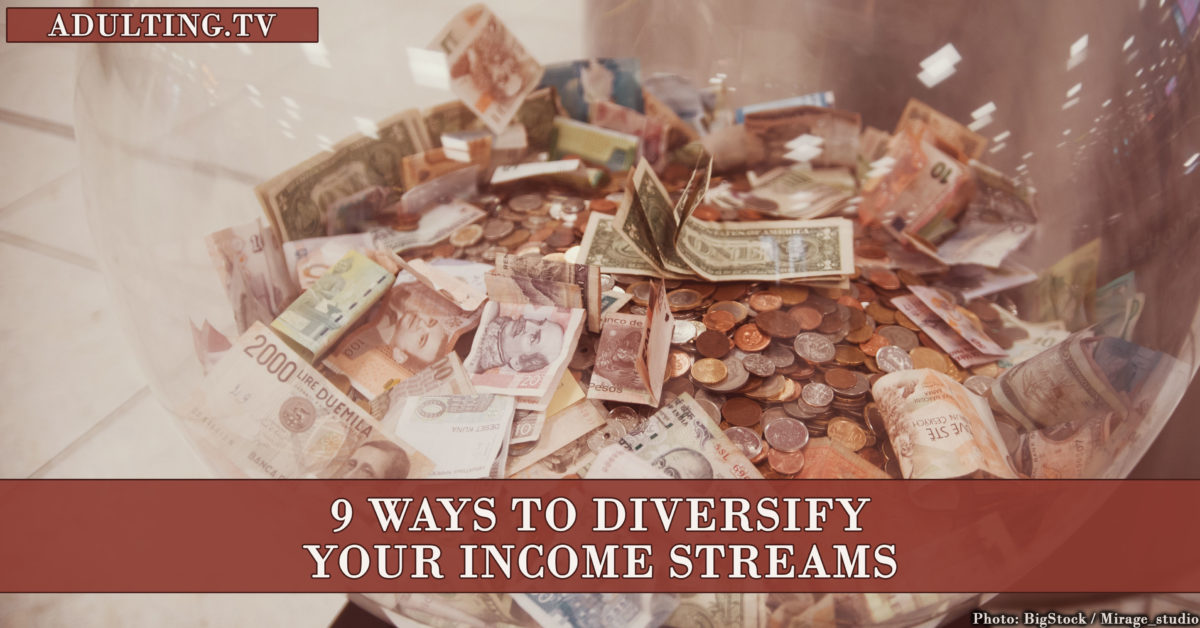A recent study in the U.K. showed that kids no longer aspire to be singers, actors or athletes. They’d rather be business leaders and entrepreneurs.
Well, that’s just dandy. No, it really is.
Sure, I wanted to grow up to be Madonna or even Stevie Nicks. But, for many reasons (obvious and not so obvious) that was never going to work out. I got into business — much to the relief of my parents. That worked out pretty well. I made it to middle-management and life was easy.
Then, I got the bug!
I couldn’t work for someone else any longer, wanted to do my own thing, and I knew what I wanted to do. Then, life wasn’t so easy. The life of an entrepreneur is a roller coaster. However, I wouldn’t change it for the world because now that I’ve survived the good, the bad and the ugly, it’s excellent.
One of the reasons my business is good to me is that I’m no longer reliant on one stream of income. The second and better reason is I’m no longer reliant on one person for my income. Finally, there’s diversity in what I do. Today, alone, I’m working on three of the incomes streams I mention below. If I wanted to, I could choose to do none of them.
To me, that speaks to the power when you diversify your income streams if you want to be an entrepreneur today. Here are my recommendations for you to consider and how I’m using (most of) them.
1. Monetize your blog.
You already know that I want you to become a blogger. I want everyone to become a blogger. I think blogs are as important as resumes. Plus, they can create the opportunity for you to go solo. There are many benefits to having your blog, some of which I’ll include in the following.
One of the easiest ways to make money from blogging is to monetize your blog. Google Ad Sense and Amazon Affiliate Links are probably the two most popular and accessible ways to monetize your blog. There are other companies you can you, but these are the only two I’ve used, so I don’t want to mention them.
When I first started blogging, we used Google Ad Sense that included a banner ad at the top and bottom of our blog and a square ad on the right rail of our blog. Choosing specific parameters, I permitted Google to rotate ads carousel-style on my blog.
Because you make money when people who visit your blog click on these ads, the more traffic you have, the better your return on your investment (ROI). Over time Google Ad Sense and their competition have decreased in their ROI, but they’re still an easy way to make money when you start blogging.
I use Amazon Affiliates for two reasons. The first is I have more control of what I promote on my blog. I don’t run the risk of advertising the vacuum cleaner of the week to my audience who has no interest in vacuum cleaners.
On top of that, I don’t have unrelated banner and square ads taking up real estate on my blog. Amazon Affiliate links are a better way than Google Ad Sense to make money in our experience. We have a blogger friend whose whole business is based on Amazon Affiliate Links.
2. Add affiliate marketing to your blog.
The most lucrative marketing strategy, at least for me, is affiliate marketing. Affiliating marketing is when you establish a relationship with a company to promote or sell their product on your blog.
The reason affiliate marketing is lucrative is two-fold. First, the affiliate payouts are better — at least for the companies I partner. My blog is about personal finance for the LGBTQ community, and all my affiliates are finance related.
The second reason affiliate marketing is lucrative is because I only affiliate with partners that can serve my niche. For example, when I talk about the benefits of refinancing a loan, I can link directly to an affiliate of mine that does that. My readers don’t see an ad for the vacuum cleaner of the week when I’m helping them lower their interest rates.
Another friend of mine has a course about making money with affiliate marketing. If this is something you want to learn, check it out.
3. Start freelance writing.
Freelance writing has been good to me, but it took me a while to earn credentials to become a freelance writer. I’m glad about that. Of course, I wanted to get paid for my writing the first day I started blogging. When I look back on my first blog articles, though, I recognize that they’re horrible.
Blogging for myself for years helped me find my voice and style — learn more about being a better writer. That time was valuable.
When you’re ready to write for others, it’s worth it. It’s helpful, though not necessary, to find clients in the niche you’ve established for yourself on your blog. I’ve seen it’s easier to sell yourself because your portfolio aligns with your potential client’s needs.
That said, I write for Adulting, which isn’t exclusively about personal finance. It’s been fun and worthwhile for me.
Another friend of mine has a course that teaches you how to become a freelance writer, even making it your primary income stream. If this interests you, I highly recommend her course.
4. Connect with brands for brand partnerships.
Brand partnerships are fun! I’ve done everything from simply attending an event to being part of a game show.
As your following grows on your blog, and as your email list gets bigger, and as your social media presence grows, you’ll become an “influencer.”
Fancy, huh?
Simply advertising on television and radio aren’t marketing strategies anymore. Brands partner with people or other businesses that have a following to generate interest and excitement in their products and services.
For this income stream, Twitter has been invaluable. Twitter’s struggling, and many think Twitter’s dead, but for me, it’s been great because it’s the primary way that I’ve been able to connect with top brands in my niche.
Again, I’ve only partnered with brands I believe in, and that align with my business’s mission. I don’t want to bring my readers to an event where they’ll be sold something that will sabotage their goals and our relationship.
As my social media following has grown, I’m having discussions with brands that aren’t in my niche but with whom there could be a symbiotic relationship.
5. Become a public speaker.
Public speaking is also fun after the nauseous pit in your stomach goes away, at least for me. Now that I’ve overcome that feeling, public speaking has been good to me.
Having a voice on your blog makes getting into public speaking because people and businesses want to know what you have to say before they hire you to say it. Again, having a social media following helps, too. Companies like it when you can attract an audience to an event.
Public speaking can be very lucrative once you’re even slightly established. If you get into public speaking, you’ll do some gigs for free. Just like with your first articles, you’ll eventually feel that not getting paid for your first public speaking gigs is a good thing.
Once you’ve gotten better at the craft, the trajectory to earn good money is slightly less than vertical. An added perk with public speaking in cities where you don’t live is that the people and businesses that hire you expect to pay for your travel, hotel, and some food.
Another friend of mine has a public speaking course, that’s all about how to get into the public speaking space. It’s the course I use and some of his templates I still use today.
6. Become a podcaster.
Honestly, I fell into podcasting totally by accident. Thank heavens I did fall into it.
I love podcasting because it’s a wealth of information. I’m gay. My husband’s gay. Our platform is personal finance for the LGBTQ community. One might think that I know my community inside and out. But I don’t. There is so much that I don’t know — and my podcast helped me see that.
When I learn something new on my podcast, I research it and learn how my business can help. This new knowledge gives me content for future podcasts, freelancing writing, and articles for my blog that link to affiliates with solutions. See the cycle?
Podcasting has also been a good income stream for me. Some of my brand partnerships have happened in part because I’ve included my podcast as a selling feature with the partnership. Also, because brands want to connect with my niche, the LGBTQ community, brands have asked to sponsor my show.
7. Sell courses.
I’m creating my first course now. As you can see from all my recommendations above, many online entrepreneurs create courses on topics they’re capable of teaching. Even before you start doing any of the above, you may already be an expert in something you can teach.
That’s great! Don’t wait. Create your course. Make your course your main platform.
Is it easier to sell your course after you’ve generated a steady stream of traffic to your site and after you have a substantial social media following? Yes.
Is that the only path? No.
I have another friend/colleague, who established her course as her platform and her blog traffic and social media following followed.
Being creative with marketing your course may make my above recommendations easier or unnecessary.
8. Be a social media manager.
My next two recommendations aren’t income streams for me, but I know many people for whom they are.
Social media is essential for bloggers. It can be a full-time job itself. In fact, for many bloggers, it is. That’s why they hire out their social media to social media managers. As your business, brand and social media following grow, it’s harder to stay engaged with your social media followers personally. Your blog traffic and your social media following are your bread and butter. Don’t dismiss it.
The good thing about becoming a social media manager is that if you like (or are already good with) one or more social media platforms, research on YouTube and with podcasts how to become a social media manager for someone else, and you can make yourself a nice income.
As with anything, you may need to start at the bottom of the income ladder, but it won’t be long before you can make this a part of your income stream.
9. Help others by becoming a virtual assistant.
Though I haven’t been a virtual assistant, I desperately need one. The job description for a virtual assistant is broad, and you can define it on your terms. Virtual assistants:
- Manage emails
- Manage calendars
- Manage social media
- Help with editing
- Website/blog design
- Research
- Act as personal assistants
- Other random items
What and how much service you provide will help determine how much you charge, commensurate with experience. If you need, start out simple and small. As time goes on, add more skills to your resume and increase your prices.
The most significant selling point of being a virtual assistant, in addition to the income stream, is that you virtually assist from literally anywhere in the world. It’s in the job title. Want to work from Idaho Falls? Do it. Want to work from a beach in the Caribbean? The option is yours.
These are just nine ways you can diversify income streams. They’re not the only ways. Hopefully, these nine will get your entrepreneur brain churning on all the ways you can make money in addition to working for your boss or working for yourself.


![[B037] Boost Your Confidence to Be Your Own Boss ft. Monica Louie](https://adulting.tv/wp-content/uploads/2017/09/monica-louie-1200x628.jpg)




![[A064] Live the Dream: Set Up Your Work From Home Situation](https://adulting.tv/wp-content/uploads/2017/03/a064-1200x628.jpg)

![[B017] Work and Play Abroad ft. Sarah Li Cain, High Fiving Dollars](https://adulting.tv/wp-content/uploads/2017/01/work-play-abroad-1200x628.jpg)
![[B016] The Perfect Product to Sell Online](https://adulting.tv/wp-content/uploads/2017/02/perfect-product-sell-online-1200x628.jpg)